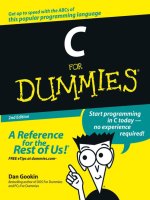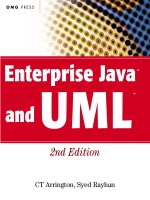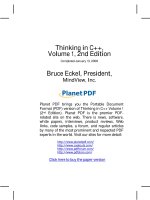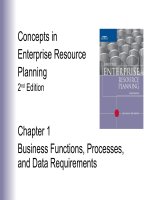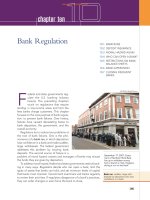Ebook Data structures and problem solving using C++ (2nd edition) Part 1
Bạn đang xem bản rút gọn của tài liệu. Xem và tải ngay bản đầy đủ của tài liệu tại đây (8.18 MB, 439 trang )
DATA STRUCTURES AND
PROBLEM SOLVING USING C++
Second Edition
MARK ALLEN WElSS
Florida International U n i v e r s i ~
Pearson Education International Inc., Upper Saddle River, N.J. 07458
If you purchased this book within the United States or Canada
you should be aware that it has been wrongfully imported
without the approval of the Publisher or the Author.
Acquisitions Editor: Susan Hartman
Project Editor: Katherine Harutunian
Production Management: Shepherd, lnc.
Composition: Shepherd. Inc.
Cover Design: Diana Coe
Cover Photo: O Mike ShepherdPhotonica
Many of the designations used by manufacturers and sellers to distinguish their products are claimed as trademarks.
Where those designations appear in this book, and the publisher was aware of a trademark claim. the des~gnationshave
been printed in ~nitialcaps or in all caps.
The programs and the applications presented In this book have been included for their instruct~onalvalue. They have
been tested with care but are not guaranteed for any particular purpose. Neither the publisher or the author offers any
warranties or representations. nor do they accept any liabilities with respect to the programs or applications.
@Copyright 2003 Pearson Education International
Upper Saddle River. N.J. 04758
@Copyright 2002 by Addison Wesley Longman, Inc.
All rights reserved. No part of this publication may be reproduced. stored In a database or retrieval system.
or transmitted in any form or by any means. electronic, mechanical, photocopying, recording. or any other
media embodiments now known or hereafter to become known. without the prior written permis5lon of the
publisher. Printed in the United States of Amenca.
ISBN: 0321 205006
10987654321
I Contents
Part I: Objects and C++
Chapter 1
Arrays, Pointers, and Structures 3
I .I
What Are Pointers, Arrays, and Structures? 3
1.2 Arrays and Strings 4
1.2.1
First-Class Versus Second-Class Objects 4
1.2.2
Using the vector 6
1.2.3
Resizing a vector 7
1.2.4
gush-back:sizeandcapacity 1 1
1.2.5
Parameter-Passing Mechanisms 1 1
1.2.6
Primitive Arrays of Constants 13
1.2.7
Multidimensional Arrays 14
1.2.8
TheStandardLibrarystringType 14
1.3 Pointer Syntax in C++ 15
1.4 Dynamic Memory Management 20
1.4.1
The new Operator 2 1
I .4.2
Garbage Collection and delete 21
1.4.3
Stale Pointers, Double Deletion, and More 22
1.5 Reference Variables 24
1.6 Structures 26
1.6.1
Pointers to Structures 28
1.6.2
Exogenous Versus Indigenous Data and Shallow Versus Deep
Copying 29
1.6.3
Noncontiguous Lists: Linked Lists 30
Summary 32
Objects of the Game 32
Common Errors 34
On the Internet 35
Exercises 35
References 38
Chapter 2
Objects and Classes 41
2.1
2.2
What Is Object-Oriented Programming? 4 1
Basic class Syntax 43
2.2.1
Class Members 43
2.2.2
Extra Constructor Syntax and Accessors 45
2.2.3
Separation of Interface and Implementation 48
2.2.4
The Big Three: Destructor, Copy Constructor, and
operator= 51
2.2.5
Default Constructor 57
2.3
Additional C++ Class Features 57
2.3.1
Initialization Versus Assignment in the Constructor
Revisited 61
2.3.2
Type Conversions 63
2.3.3
Operator Overloading 64
2.3.4
Input and Output and Friends 67
2.4
Some Common Idioms 68
2.4.1
Avoiding Friends 70
2.4.2
Static Class Members 7 I
2.4.3
The enum Trick for Integer Class Constants 71
2.5
Exceptions 72
A string Class 73
2.6
2.7
Recap: What Gets Called and What Are the Defaults? 82
2.8
Composition 84
Summary 85
Objects of the Game 85
Common Errors 87
On the Internet 89
Exercises 90
References 96
Chapter 3
3.1
3.2
3.3
3.4
3.5
Templates 97
What Is a Template? 97
Function Templates 98
A Sorting Function Template 100
Class Templates 103
3.4.1
A MemoryCell Template 103
3.4.2
Implementing the vector Class Template 108
Templates of Templates: A matrix Class 108
3.5.1
The Data Members, Constructor. and Basic Accessors 1 1 1
3.5.2
operator [ I 112
3.5.3
Destructor, Copy Assignment, and Copy Constructor 112
--
Contents
Fancy Templates 1 12
3.6.1
Multiple Template Parameters 1 12
3.6.2
Default Template Parameters 1 13
3.6.3
The Reserved Word typename 1 13
3.7
Bugs Associated with Templates 1 14
3.7.1
Bad Error Messages and Inconsistent Rules
3.7.2
Template-Matching Algorithms 1 14
3.7.3
Nested Classes in a Template 114
3.7.4
Static Members in Class Templates 1 15
Summary 1 15
Objects of the Game 1 15
Common Errors 1 15
On the Internet 1 16
Exercises 1 17
3.6
1 14
Chapter 4
Inheritance 119
4. I
What Is Inheritance? 1 19
4.2
Inheritance Basics 123
4.2.1
Visibility Rules 124
4.2.2
The Constructor and Base Class Initialization 125
4.2.3
Adding Members 126
4.2.4
Overriding a Method 128
4.2.5
Static and Dynamic Binding 129
4.2.6
The Default Constructor, Copy Constructor, Copy Assignment
Operator, and Destructor 13 1
4.2.7
Constructors and Destructors: Virtual or Not Virtual? 132
4.2.8
Abstract Methods and Classes 133
4.3
Example: Expanding the Shape Class 136
4.4 Tricky C++ Details 142
4.4.1
Static Binding of Parameters 142
4.4.2
Default Parameters 143
4.4.3
Derived Class Methods Hide Base Class Methods 144
4.4.4
Compatible Return Types for Overridden Methods 145
4.4.5
Private Inheritance 146
4.4.6
Friends 146
4.4.7
Call by Value and Polymorphism Do Not Mix 146
4.5
Multiple Inheritance 147
Summary 149
Objects of the Game 149
Common Errors 150
On the Internet 152
Exercises 152
R e f e r e n c e s 154
- - -
- -
-
-
-
-
-
-
-
-
-
-
-
Chapter 5
Design Patterns 155
5.1
What Is a Pattern'? 155
5.2 The Functor (Function Objects) 156
5.3 Adapters and Wrappers 162
5.3.1
Wrapper for Pointers 162
5.3.2
A Constant Reference Wrapper 168
5.3.3
Adapters: Changing an Interface 169
5.4 lterators 170
5.4.1
Iterator Design 1 171
5.4.2
Iterator Design 2 174
5.4.3
Inheritance-Based Iterators and Factories
5.5 Composite (Pair) 179
5.6 Observer 179
Summary 184
Objects of the Game 184
Common Errors 185
On the Internet 186
Exercises 186
References 190
174
Part ZI: Algorithms and Building Blocks
Chapter 6
Algorithm Analysis 193
6.1
What Is Algorithm Analysis? 193
6.2 Examples of Algorithm Running Times 198
6.3 The Maximum Contiguous Subsequence Sum Problem
6.3.1
The Obvious O(N3) Algorithm 200
6.3.2
An Improved O(N2) Algorithm 203
6.3.3
A Linear Algorithm 204
6.4 General Big-Oh Rules 206
6.5 The Logarithm 2 1 1
6.6 Static Searching Problem 21 4
6.6.1
Sequential Search 2 14
6.6.2
Binary Search 215
6.6.3
Interpolation Search 217
6.7 Checking an Algorithm Analysis 2 19
6.8 Limitations of Big-Oh Analysis 220
199
Contents
Summary 221
Objects of the Game 22 1
Common Errors 222
On the Internet 223
Exercises 223
References 228
Chapter 7
The Standard Template Library 231
7.1
Introduction 232
7.2 Stacks and Queues 233
7.2.1
Stacks 233
7.2.2
Stacks and Computer Languages 235
7.2.3
Queues 236
7.3 Containers and Iterators 237
7.3.1
Containers 238
7.3.2
The i t e r a t o r 238
7.4 STL Algorithms 240
7.4.1
STL Function Objects 240
7.4.2
Binary Search 243
7.4.3
Sorting 244
7.5
Implementation of vector with an Iterator 245
7.6 Sequences and Linked Lists 247
7.6.1
T h e l i s t c l a s s 247
7.6.2
Stacks and Queues 249
7.7 Sets 249
7.8
Maps 251
7.9 Priority Queues 253
Summary 257
Objects of the Game 257
Common Errors 259
On the Internet 259
Exercises 260
References 264
Chapter 8
Recursion 265
8.1
What Is Recursion? 265
8.2 Background: Proofs by Mathematical Induction 267
8.3
Basic Recursion 269
8.3.1
Printing Numbers in Any Base 27 1
8.3.2
Why It Works 274
8.3.3
How It Works 275
8.3.4
Too Much Recursion Can Be Dangerous 276
8.3.5
Preview of Trees 278
8.3.6
Additional Examples 279
8.4 Numerical Applications 284
8.4.1
Modular Arithmetic 285
8.4.2
Modular Exponentiation 285
8.4.3
Greatest Common Divisor and Multiplicative Inverses 287
8.4.4
The RSA Cryptosystem 289
8.5
Divide-and-Conquer Algorithms 292
8.5.1
The Maximum Contiguous Subsequence Sum Problem 293
8.5.2
Analysis of a Basic Divide-and-Conquer Recurrence 297
8.5.3
A General Upper Bound for Divide-and-Conquer Running
Times 301
8.6 Dynamic Programming 303
8.7 Backtracking 308
Summary 3 10
Objects of the Game 3 12
Common Errors 3 13
On the Internet 3 14
Exercises 3 14
References 3 19
Chapter 9
Sorting Algorithms 321
9.1 Why Is Sorting Important? 322
9.2
Preliminaries 323
9.3
Analysis of the Insertion Sort and Other Simple Sorts 324
9.4
Shellsort 326
9.4.1
Performance of Shellsort 328
9.5
Mergesort 330
9.5.1
Linear-Time Merging of Sorted Arrays 330
9.5.2
The Mergesort Algorithm 332
9.6 Quicksort 334
9.6.1
The Quicksort Algorithm 335
9.6.2
Analysis of Quicksort 337
9.6.3
Picking the Pivot 340
A Partitioning Strategy 342
9.6.4
9.6.5
Keys Equal to the Pivot 344
9.6.6
Median-of-Three Partitioning 345
9.6.7
Small Arrays 346
9.6.8
C++ Quicksort Routine 346
9.7
9.8
9.9
Quickselect 348
A Lower Bound for Sorting 349
Indirect Sorting 352
9.9.1
Using Pointers to Reduce Comparable Copies to 2N
9.9.2
Avoiding the Extra Array 353
Summary 355
Objects of the Game 356
Common Errors 357
On the Internet 357
Exercises 358
References 363
Chapter 10 Randomization 365
10.1 Why Do We Need Random Numbers? 365
10.2 Random Number Generators 366
10.3 Nonuniform Random Numbers 37 1
10.4 Generating a Random Permutation 373
10.5 Randomized Algorithms 375
10.6 Randomized Prjmality Testing 378
Summary 380
Objects of the Game 382
Common Errors 383
On the Internet 383
Exercises 383
References 386
Part I l l : Applications
Chapter 11 Fun and Games 389
1 1.1 Word Search Puzzles 389
11.1.1 Theory 390
1 1.1.2 C++ Implementation 39 1
1 1.2 The Game of Tic-Tac-Toe 395
I 1.2.1 Alpha-Beta Pruning 397
I 1.2.2 Transposition Tables 398
1 1.2.3 Computer Chess 404
Summary 405
Objects of the Game 405
352
--
.-A
-
Contents
Common Errors 406
On the Internet 406
Exercises 406
References 408
Chapter 12 Stacks and Compilers 409
12.1 Balanced-Symbol Checker 409
12.1.I Basic Algorithm 409
12.1.2 Implementation 4 1 1
12.2 A Simple Calculator 420
12.2.1 Postfix Machines 421
12.2.2 Infix to Postfix Conversion 422
12.2.3 Implementation 424
12.2.4 Expression Trees 432
Summary 435
Objects of the Game 435
Common Errors 436
On the Internet 436
Exercises 436
References 438
Chapter 13 Utilities 439
13.1 File Compression 439
13.1.1 Prefix Codes 440
13.1.2 Huffman's Algorithm 442
13.1.3 Implementation 445
13.2 A Cross-Reference Generator 46 1
13.2.1 Basic Ideas 46 1
13.2.2 C++ Implementation 462
Summary 466
Objects of the Game 466
Common Errors 466
On the Internet 467
Exercises 467
References 470
Chapter 14 Simulation 471
14.1 The Josephus Problem 47 1
14.l . l The Simple Solution 473
14.1.2 A More Efficient Algorithm
473
14.2 Event-Driven Simulation 475
14.2.1 Basic Ideas 477
14.2.2 Example: A Modem Bank Simulation
Summary 486
Objects of the Game 486
Common Errors 486
On the Internet 486
Exercises 486
478
Chapter 15 Graphs and Paths 489
15.1 Definitions 489
15.1.1 Representation 49 1
15.2 Unweighted Shortest-Path Problem 503
15.2.1 Theory 504
1 5.2.2 C++ Implementation 509
15.3 Positive-Weighted, Shortest-Path Problem 509
15.3.1 Theory: Dijkstra's Algorithm 509
15.3.2 C++ Implementation 5 13
15.4 Negative-Weighted. Shortest-Path Problem 5 14
15.4.1 Theory 514
15.4.2 C++ Implementation 5 17
15.5 Path Problems in Acyclic Graphs 5 17
15.5.1 Topological Sorting 5 17
15.5.2 Theory of the Acyclic Shortest-Path Algorithm
15.5.3 C++ Implementation 522
15.5.4 An Application: Critical-Path Analysis 522
Summary 526
Objects of the Game 527
Common Errors 528
On the Internet 529
Exercises 529
References 533
Part ZV: Zmplementations
Chapter 16 Stacks and Queues 537
16.1 Dynamic Array Implementations 537
16.1.1 Stacks 538
16.1.2 Queues 541
520
16.2 Linked List Implementations 548
16.2.1 Stacks 548
16.2.2 Queues 553
16.3 Comparison of the Two Methods 557
16.4 The STL Stack and Queue Adapters 558
16.5 Double-Ended Queues 558
Summary 559
Objects of the Game 56 1
Common Errors 561
On the Internet 56 1
Exercises 562
Chapter 17 Linked Lists 565
17.1 Basic Ideas 565
17.1.1 Header Nodes 567
17.1.2 Iterator Classes 569
17.2 C++ Implementation 570
17.3 Doubly Linked Lists and Circularly Linked Lists
17.4 Sorted Linked Lists 582
17.5 lmplementingtheSTLlistClass 582
Summary 597
Objects of the Game 597
Common Errors 598
On the Internet 598
Exercises 599
Chapter I 8 Trees 605
18.1 General Trees 605
18.1.1 Definitions 605
1 8.1.2 Implementation 607
1 8.1.3 An Application: File Systems 608
18.2 Binary Trees 61 1
18.3 Recursion and Trees 6 19
18.4 Tree Traversal: lterator Classes 622
18.4.1 Postorder Traversal 624
18.4.2 Inorder Traversal 630
18.4.3 Preorder Traversal 630
18.4.4 Level-Order Traversals 630
579
Summary 633
Objects of the Game 636
Common Errors 637
On the Internet 637
Exercises 637
Chapter 19 Binary Search Trees 641
19.1 Basic Ideas 64 1
19.1.1 The Operations 642
19.1.2 C++ lmplementation 644
19.2 Order Statistics 652
19.2.1 C++ Implementation 653
19.3 Analysis of Binary Search Tree Operations 657
19.4 AVL Trees 661
19.4.1 Properties 662
19.4.2 Single Rotation 664
19.4.3 Double Rotation 667
19.4.4 Summary of AVL Insertion 670
19.5 Red-Black Trees 670
19.5.1 Bottom-Up Insertion 672
19.5.2 Top-Down Red-Black Trees 674
19.5.3 C++ Implementation 676
19.5.4 Top-Down Deletion 680
19.6 AA-Trees 685
19.6.1 Insertion 686
19.6.2 Deletion 688
19.6.3 C++ Implementation 690
19.7 Implementing the STL set and map Classes 693
19.8 B-Trees 707
Summary 714
Objects of the Game 7 15
Common Errors 7 17
On the Internet 7 17
Exercises 7 18
References 72 1
Chapter 20 Hash Tables 725
20.1 Basic Ideas 725
20.2 Hash Function 727
20.3 Linear Probing 729
20.3.1 Naive Analysis of Linear Probing
73 1
20.3.2 What Really Happens: Primary Clustering
20.3.3 Analysis of the find Operation 733
20.4 Quadratic Probing 735
20.4.1 C++ Implementation 739
20.4.2 Analysis of Quadratic Probing 745
20.5 Separate Chaining Hashing 746
20.6 Hash Tables Versus Binary Search Trees 746
20.7 Hashing Applications 747
Summary 747
Objects of the Game 748
Common Errors 749
On the Internet 749
Exercises 749
References 752
732
Chapter 21 A Priority Queue: The Binary Heap 755
21.1 Basic Ideas 755
2 1.1.1 Structure Property 756
2 1.1.2 Heap-Order Property 758
2 1.1.3 Allowed Operations 759
21.2 Implementation of the Basic Operations 761
2 1.2.1 The insert Operation 762
21.2.2 The deleteMin Operation 763
2 1.3 The buildHeap Operation: Linear-Time Heap Construction
21.4 STL priority-queue lmplementation 77 1
21.5 Advanced Operations: decreaseKey and merge 773
2 1.6 Internal Sorting: Heapsort 773
2 1.7 External Sorting 778
21.7.1 Why We Need New Algorithms 778
2 1.7.2 Model for External Sorting 778
21.7.3 The Simple Algorithm 779
2 1.7.4 Multiway Merge 78 1
2 1.7.5 Polyphase Merge 782
21.7.6 Replacement Selection 783
Summary 785
Objects of the Game 785
Common Errors 786
On the Internet 787
Exercises 787
References 79 1
766
Part V: Advanced Data Structures
Chapter 22 Splay Trees 795
22.1 Self-Adjustment and Amortized Analysis 795
22.1 .I Amortized Time Bounds 797
22.1.2 A Simple Self-Adjusting Strategy (That Does Not Work) 797
22.2 The Basic Bottom-Up Splay Tree 799
22.3 Basic Splay Tree Operations 802
22.4 Analysis of Bottom-Up Splaying 803
22.4.1 Proof of the Splaying Bound 806
22.5 Top-Down Splay Trees 809
22.6 Implementation of Top-Down Splay Trees 81 2
22.7 Comparison of the Splay Tree with Other Search Trees 8 18
Summary 8 19
Objects of the Game 8 19
Common Errors 820
On the Internet 820
Exercises 820
References 822
Chapter 23 Merging Priority Queues 823
23.1 The Skew Heap 823
23.1.1 Merging Is Fundamental 823
23.1.2 Simplistic Merging of Heap-Ordered Trees 824
23.1.3 The Skew Heap: A Simple Modification 825
23.1.4 Analysis of the Skew Heap 826
23.2 The Pairing Heap 828
23.2.1 Pairing Heap Operations 829
23.2.2 Implementation of the Pairing Heap 830
23.2.3 Application: Dijkstra's Shortest Weighted Path Algorithm
Summary 840
Objects of the Game 840
Common Errors 84 1
On the Internet 84 1
Exercises 84 1
References 842
Chapter 24 The Disjoint Set Class 845
24.1 Equivalence Relations 845
24.2 Dynamic Equivalence and Two Applications
846
836
contents
-
-
-
-
--
24.2.1 Application: Generating Mazes 847
24.2.2 Application: Minimum Spanning Trees 850
24.2.3 Application: The Nearest Common Ancestor Problem
24.3 The Quick-Find Algorithm 857
24.4 The Quick-Union Algorithm 858
24.4.1 Smart Union Algorithms 860
24.4.2 Path Compression 862
24.5 C++ Implementation 863
24.6 Worst Case for Union-by-Rank and Path Compression 865
24.6.1 Analysis of the UnionIFind Algorithm 866
Summary 873
Objects of the Game 873
Common Errors 875
On the Internet 875
Exercises 875
References 877
Appendices
Appendix A Miscellaneous C++ Details A-3
A. 1 None of the Compilers Implement the Standard A-3
A.2 Unusual C++ Operators A-4
A.2.1
Autoincrement and Autodecrement Operators
A.2.2
Type Conversions A-5
A.2.3
Bitwise Operators A-6
A.2.4
The Conditional Operator A-8
A.3 Command-Line Arguments A-8
A.4 Input and Output A-9
A.4.1
Basic Stream Operations A-9
A.4.2
Sequential Files A- 13
A.4.3
String Streams A- 13
A.5 Namespaces A-15
A.6 New C++ Features A- 17
Common C++ Errors A- 17
A-4
853
Appendix B
Operators A-21
Appendix C Some Library Routines A-23
C.l
Routines Declared in <ctype. h> and <cctype> A-23
C.2 Constants Declared in <limits. h> and <climits> A-24
C.3 Routines Declared in <math.h> and <cmath> A-25
C.4 Routines Declared in <stdlib.h> and <cstdlib> A-26
Appendix D Primitive Arrays in C++ A-27
D.1 Primitive Arrays A-27
The C++ Implementation: An Array Name Is a Pointer A-28
D. 1 . 1
D. 1.2 Multidimensional Arrays A-3 1
D. I .3 The char * Type, const Pointers, and Constant Strings A-3 I
D.2 Dynamic Allocation of Arrays: new [ ] and delete [ I A-35
D.3 Pointer Arithmetic, Pointer Hopping, and Primitive Iteration A-4 1
D.3.1
Implications of the Precedence of *, &, and [ I A-41
D.3.2 What Pointer Arithmetic Means A-42
D.3.3 A Pointer-Hopping Example A-44
D.3.4
Is Pointer Hopping Worthwhile? A-45
Common C++ Errors A-47
On the Internet A-47
I Preface
This book is designed for a two-semester sequence in computer science,
beginning with what is typically known as Data Structures (CS-2) and continuing with advanced data structures and algorithm analysis.
The content of the CS-2 course has been evolving for some time.
Although there is some general consensus concerning topic coverage, considerable disagreement still exists over the details. One uniformly accepted
topic is principles of software development, most notably the concepts of
encapsulation and information hiding. Algorithmically, all CS-2 courses
tend to include an introduction to running-time analysis, recursion, basic
sorting algorithms, and elementary data structures. An advanced course is
offered at many universities that covers topics in data structures, algorithms,
and running-time analysis at a higher level. The material in this text has been
designed for use in both levels of courses, thus eliminating the need to purchase a second textbook.
Although the most passionate debates in CS-2 revolve around the choice
of a programming language, other fundamental choices need to be made,
including
whether to introduce object-oriented design or object-based design
early,
the level of mathematical rigor,
the appropriate balance between the implementation of data structures and their use, and
programming details related to the language chosen.
My goal in writing this text was to provide a practical introduction to
data structures and algorithms from the viewpoint of abstract thinking and
problem solving. I tried to cover all of the important details concerning the
data structures, their analyses, and their C++ implementations, while staying
away from data structures that are theoretically interesting but not widely
used. It is impossible to cover in a single course all the different data structures, including their uses and the analysis, described in this text. So, I
designed the textbook to allow instructors flexibility in topic coverage. The
instructor will need to decide on an appropriate balance between practice
and theory and then choose those topics that best fit the course. As I discuss
later in this Preface, I organized the text to minimize dependencies among
the various chapters.
A Unique Approach
My basic premise is that software development tools in all languages come
with large libraries, and many data structures are part of these libraries. I
envision an eventual shift in emphasis of data structures courses from implementation to use. In this book I take a unique approach by separating the
data structures into their specification and subsequent implementation and
take advantage of an already existing data structures library, the Standard
Template Library (STL).
A subset of the STL suitable for most applications is discussed in a single chapter (Chapter 7) in Part 11. Part 11 also covers basic analysis techniques, recursion, and sorting. Part I11 contains a host of applications that
use the STL's data structures. Implementation of the STL is not shown until
Part IV, once the data structures have already been used. Because the STL is
part of C++ (older compilers can use the textbook's STL code instead-see
Code Availability, xxix), students can design large projects early on, using
existing software components.
Despite the central use of the STL in this text, it is neither a book on the
STL nor a primer on implementing the STL specifically; it remains a book
that emphasizes data structures and basic problem-solving techniques. Of
course, the general techniques used in the design of data structures are applicable to the implementation of the STL, so several chapters in Part IV
include STL implementations. However, instructors can choose the simpler
implementations in Part IV that do not discuss the STL protocol. Chapter 7,
which presents the STL, is essential to understanding the code in Part 111. I
attempted to use only the basic parts of the STL.
Many instructors will prefer a more traditional approach in which each
data structure is defined, implemented, and then used. Because there is no
dependency between material in Parts I11 and IV, a traditional course can
easily be taught from this book.
Prerequisites
Students using this book should have knowledge of either an object-oriented
or procedural programming language. Knowledge of basic features, including primitive data types, operators, control structures, functions (methods),
and input and output (but not necessarily arrays and classes) is assumed.
Students who have taken a first course using C++ or Java may find the
first two chapters "light" reading in some places. However, other parts are
definitely "heavy" with C++ details that may not have been covered in introductory courses.
Students who have had a first course in another language should begin at
Chapter 1 and proceed slowly. They also should consult Appendix A which
discusses some language issues that are somewhat C++ specific. If a student
would like also to use a C++ reference book, some recommendations are
given in Chapter 1, pages 38-39.
Knowledge of discrete math is helpful but is not an absolute prerequisite. Several mathematical proofs are presented, but the more complex
proofs are preceded by a brief math review. Chapters 8 and 19-24 require
some degree of mathematical sophistication. The instructor may easily elect
to skip mathematical aspects of the proofs by presenting only the results. All
proofs in the text are clearly marked and are separate from the body of the
text.
Summary of Changes in the Second Edition
1. Much of Part I was rewritten. In Chapter 1, primitive arrays are no
longer presented (a discussion of them was moved to Appendix D);
vectors are used instead, and push-back is introduced. Pointers
appear later in this edition than in the first edition. In Chapter 2,
material was significantly rearranged and simplified. Chapter 3 has
additional material on templates. In Chapter 4, the discussion on
inheritance was rewritten to simplify the initial presentation. The
end of the chapter contains the more esoteric C++ details that are
important for advanced uses.
2. An additional chapter on design patterns was added in Part I. Several object-based patterns, including Functor, Wrapper, and Iterator,
are described, and patterns that make use of inheritance. including
Observer, are discussed.
3. The Data Structures chapter in Part I1 was rewritten with the STL in
mind. Both generic interfaces (as in the first edition) and STL interfaces are illustrated in the revised Chapter 7.
4. The code in Part I11 is based on the STL. In several places, the code
is more object-oriented than before. The Huffman coding example
is completely coded.
5. In Part IV, generic data structures were rewritten to be much simpler and cleaner. Additionally, as appropriate, a simplified STL
implementation is illustrated at the end of the chapters in Part IV.
lmplemented components include vector, 1ist, stack,queue,
set, map, priority-queue, and various function objects and
algorithms.
Using C++ presents both advantages and disadvantages. The C++ class
allows the separation of interface and implementation, as well as the hiding of internal details of the implementation. It cleanly supports the notion
of abstraction. The advantage of C++ is that it is widely used in industry.
Students perceive that the material they are learning is practical and will
help them find employment, which provides motivation to persevere
through the course. One disadvantage of C++ is that it is far from a perfect
language pedagogically, especially in a second course, and thus additional
care needs to be expended to avoid bad programming practices. A second
disadvantage is that C++ is still not a stable language, so the various compilers behave differently.
It might have been preferable to write the book in a language-independent fashion, concentrating only on general principles such as the theory of
the data structures and referring to C++ code only in passing, but that is
impossible. C++ code is complex, and students will need to see complete
examples to understand some of its finer points. As mentioned earlier, a brief
review of parts of C++ is provided in Appendix A . Part I of the book
describes some of C++'s more advanced features relevant to data structures.
Several parts of the language stand out as requiring special consideration: templates, inheritance, exceptions, namespaces and other recent C++
additions, and the Standard Library. 1 approached this material in the following manner.
Templates: Templates are used extensively. Some instructors may
have reservations with this approach because it complicates the code,
but I included them because they are fundamental concepts in any
sophisticated C++ program.
I~zheritance: I use inheritance relatively sparingly because it adds
complications, and data structures are not a strong application area
-- --
Preface
for it, This edition contains less use of inheritance than in the previous edition. However, there is a chapter on inheritance, and part of the
design patterns chapter touches on inheritance-based patterns. For the
most part, instructors who are eager to avoid inheritance can do so,
and those who want to discuss inheritance will find sufficient material
in the text.
Exceptions: Exception semantics have been standardized and
exceptions seem to work on many compilers. However, exceptions
in C++ involve ugly code, significant complications (e.g., if used in
conjunction with templates), and probably require discussing inheritance. So I use them sparingly in this text. A brief discussion of
exceptions is provided, and in some places exceptions are thrown in
code when warranted. However, I generally do not attempt to catch
exceptions in any Part I11 code (most of the Standard Library does
not attempt to throw exceptions).
Namespaces: Namespaces, which are a recent addition to C++, do not
work correctly on a large variety of compilers. I do not attempt to use
namespaces and I import the entire s t d namespace when necessary
(even though not great style, it works on the largest number of compilers). Appendix A discusses the namespace issues.
Recent language additions: The boo1 data type is used throughout.
The new s t a t i c - c a s t operator is used in preference to the old-style
cast. Finally, I use e x p l i c i t when appropriate. For the most part,
other additions are not used (e.g., I generally avoid using typename).
Standard Library: As previously mentioned, the STL is used throughout, and a safe version (that does extra bounds checking) is available
online (and implemented in Part IV). We also use the s t r i n g class
and the newer i s t r i n g s t r e a m class that are part of the standard
library.
Text Organization
In this text I introduce C++ and object-oriented programming (particularly
abstraction) in Part I. I discuss arrays, pointers and some other C++ topics
and then go on to discuss the syntax and use of classes, templates, and inheritance. The material in these chapters was substantially rewritten. New to
this edition is an entire chapter on design patterns.
In Part I1 I discuss Big-Oh and algorithmic paradigms, including recursion and randomization. An entire chapter is devoted to sorting, and a separate chapter contains a description of basic data structures. I use the STL in
presenting the interfaces and running times of the data structures. At this
Preface
point in the text, the instructor may take several approaches to present the
remaining material, including the following two.
I . Discuss the corresponding implementations (either the STL versions or the simpler versions) in Part IV as each data structure is
described. The instructor can ask students to extend the classes in
various ways, as suggested in the exercises.
2. Show how the STL class is used and cover implementation at a later
point in the course. The case studies in Part 111 can be used to support this approach. As complete implementations are available on
every modern C++ compiler (or on the Internet for older compilers). the instructor can use the STL in programming projects.
Details on using this approach are given shortly.
Part V describes advanced data structures such as splay trees, pairing
heaps, and the disjoint set data structure, which can be covered if time permits or, more likely, in a follow-up course.
Chapter-by-ChapterText Organization
Part I consists of ti ve chapters that describe some advanced features of C++
used throughout the text. Chapter I describes arrays, strings, pointers, references, and structures. Chapter 2 begins the discussion of object-oriented programming by describing the class mechanism in C++. Chapter 3 continues
this discussion by examining templates, and Chapter 4 illustrates the use of
inheritance. Several components, including strings and vectors, are written
in these chapters. Chapter 5 discusses some basic design patterns, focusing
mostly on object-based patterns such as function objects, wrappers and
adapters, iterators, and pairs. Some of these patterns (most notably the wrapper pattern) are used later in the text.
Part IT focuses on the basic algorithms and building blocks. In Chapter 6
a complete discussion of time complexity and Big-Oh notation is provided,
and binary search is also discussed and analyzed. Chapter 7 is crucial
because it covers the STL and argues intuitively what the running time of the
supported operations should be for each data structure. (The implementation
of these data structures. in both STL-style and a simplified version, is not
provided until Part IV. The STL is available on recent compilers.) Chapter 8
describes recursion by ti rst introducing the notion of proof by induction. It
also discusses divide-and-conquer, dynamic programming, and backtracking. A section describes several recursive numerical algorithms that are used
to implement the RSA cryptosystem. For many students, the material in the
